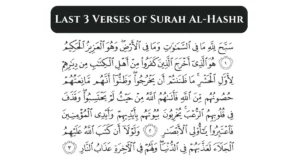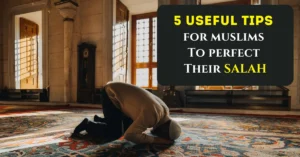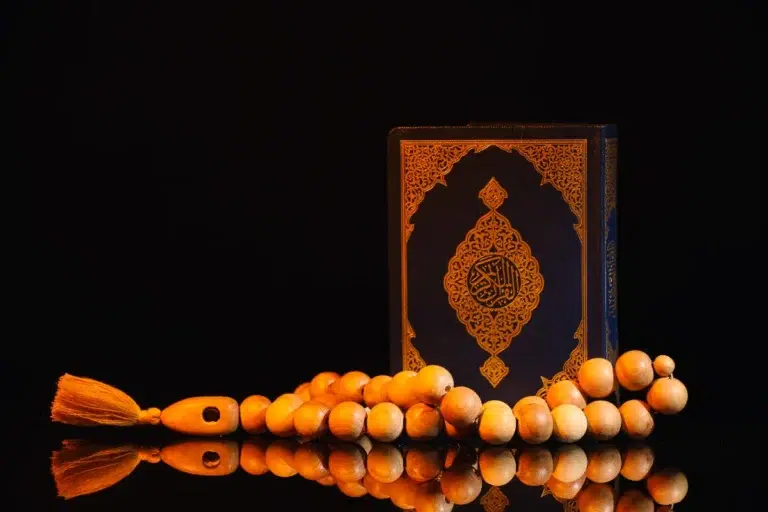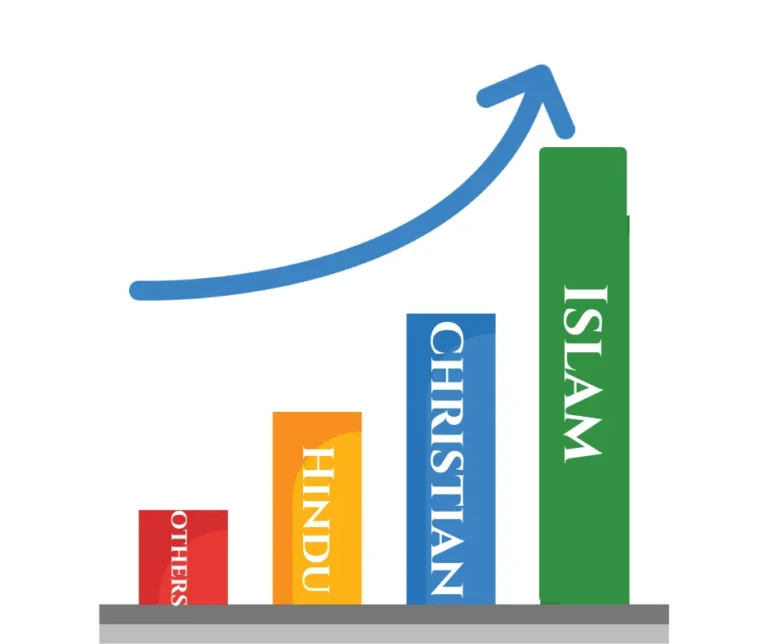Introduction
The Qibla is an essential concept in Islam. The Qiblah is the direction Muslims face when performing their five daily prayers (Salah). The direction of the Qibla is universally recognized as towards the Kaaba, the sacred cube-shaped structure in Mecca, Saudi Arabia. The Kaaba is central to Islamic tradition and is considered the House of Allah (SWT).
For more information about the Kaaba, visit this link: The Kaaba: History and Significance in Islam.
In the early days of Islam, the Qiblah was initially directed towards Bait-ul Maqdis (the Al-Aqsa Mosque) in Jerusalem. The historical transition of the Qiblah from Jerusalem to Mecca was a significant moment in Islamic history. This marked a new phase in Islamic history, establishing a unique identity for Muslims and solidifying their connection to the Prophet Abraham’s legacy. The Mosque of the Two Qiblas (Masjid al-Qiblatayn) in Medina, where the revelation about the change occurred midway through a prayer. Prophet Muhammad (SAW) directed this change from Masjid Al-Aqsa to Kabba.
For more information about Masjid Al-Aqsa, please visit this blog post: History of Al-Aqsa Mosque in Islam.
Reasons for the Change of Qiblah
The change in Qiblah direction was driven by many reasons rooted in social, religious, and divine guidance:
Affirmation of Islamic Identity
The change of Qiblah to Kaaba established a distinct and independent identity for Muslims, setting them apart from Jews and Christians. This action emphasized the uniqueness of Islam as a separate and sovereign faith.
Historical and Religious Significance
The Kaaba reconnected Islam with Prophet Abrahamic roots, emphasizing continuity with earlier monotheistic traditions. Muslims, by turning towards the Kaaba, acknowledge their spiritual lineage and the central role of Prophet Ibrahim (AS) in their faith.
Response to Criticism
The change addressed fears from Jewish crews in Medina and supported Islam’s particularity and authenticity. By differentiating their practices, Muslims maintained their religious identity and opposed any doubts about the lawfulness of their faith.
Divine Guidance
The revelation to change the Qiblah underscored the importance of obedience to Allah’s (SWT) commands, providing spiritual rightfulness. This divine directive proved Prophet Muhammad’s (PBUH) authority and the significance of following divine instructions in Islam.
Revelation of the New Qibla Direction
The change in the Qiblah direction was revealed to Prophet Muhammad (SAW) around 16-18 months after the Hijra (migration) to Medina. This revelation is detailed in the Quran, specifically in Surah Al-Baqarah.

This verse signifies the moment when Allah (SWT) instructed the Prophet Muhammad (SAW) to change the direction of prayer from Bait-ul Maqdis to the Kaaba in Mecca.
The First Prayer Towards Kaaba
The first prayer performed in the direction of the Kaaba took place in the mosque known as Masjid al-Qiblatayn in Medina. During the prayer, the Prophet (SAW) received a revelation, which was mentioned above, and He (SAW) immediately changed direction, leading the congregation to turn toward the Kaaba. This moment is observed in Islamic history as a witness to the quick obedience and faith of the early Muslims.
Significance of the Kaaba as the New Qiblah
The Kaaba holds deep significance as the new Qiblah in Islam. The Kaaba represents the center of monotheistic worship in Islam. It represents the principle of Tawhid, the belief in the Oneness of Allah (SWT), which is central to Islamic theology. Facing the Kaaba in prayer symbolizes devotion and submission to the one God.
For more information about Tawheed, visit this link: Tawheed: The First Pillar of Islam.
The Kaaba has historical and cultural roots dating back to Prophet Ibrahim (Abraham) (AS) and his son Prophet Isma’il (Ishmael) (AS). It is considered the first house of worship built for the worship of Allah (SWT) alone. Pilgrimage to the Kaaba during Hajj and Umrah rites further strengthens its importance as a spiritual center for Muslims.
The Qiblah Change Controversy
The Al-Aqsa Mosque is situated in the northern part of Medina, while the Kaaba is in the southern region. Consequently, the Prophet (SAW) changed the direction during prayer.
Questions have been raised about the positions of the Imam, women, and men after the change in the Qiblah. However, according to historical accounts, after the Prophet (SAW) changed the direction He (SAW) faced towards the Kaaba, he also adjusted his physical position. This adjustment adjusted the followers turning towards the Kaaba.
Religious Practices Involving the Qiblah
The primary religious practice is Salah (prayer) towards the Kaaba. Here are some other practices involving Qiblah:
Ihram (During Hajj and Umrah)
When performing Hajj or Umrah, pilgrims enter the state of Ihram, a sacred state that involves specific rituals and restrictions. Facing the Qiblah is essential during various rituals, such as Tawaf (circumambulation) around the Kaaba and prayers.
Dhabihah (Animal Slaughter)
When Muslims perform the ritual slaughter of animals (Dhabihah), it is essential that the animal’s face be towards the Qiblah. This practice ensures that the sacrifice is done with the proper intention and according to Islamic guidelines.
To get a comprehensive guide about the Qurabni, visit this blog post:
- Qurbani in Hajj: Obligations and Procedures of the Sacrifice
- Sacrifice on Eid ul Adha: Answers to Common Questions
Du’a (Supplications)
When making supplications (dua) to Allah (SWT), it is recommended to face the Qiblah. While you can make dua while facing any direction, facing the Qibla reflects humility and a sense of direction towards the most holy site in Islam.
During Burial
During burial preparations, the deceased is laid in the grave on their right side facing the Qiblah. This signifies their continued connection to Islamic practices, even in death.
These practices emphasize the significance of the Qiblah as a focal point in Islamic worship and daily life, connecting Muslims worldwide in their faith and submission to Allah (SWT).
Facing the Kabah in Different Locations
When near the Kaaba, one must face it directly. The rows of worshippers around the Kaaba are circular to adjust this. In Makkah, the direction of prayer must be towards Al-Masjid Al-Haram, while outside Makkah, facing towards Al-Masjid Al-Haram is sufficient.
Allah (SWT) says in the Quran;

Hazrat Abu Hurairah (RA) narrated that:
Allah’s Messenger (SAW) said: “What is between the east and the west is Qiblah.”
[Jami` at-Tirmidhi 342]
Qiblah Directions from Various Global Locations:
- North America: The Qiblah direction is generally northeast of cities like New York or Toronto.
- South America: In São Paulo or Buenos Aires, the Qibla direction is primarily north.
- Europe: In London or Paris, Muslims face southeast towards the Kaaba.
- Africa: From cities like Cairo or Nairobi, the Qiblah direction is generally northeast.
Determining the Qibla Direction with Modern Tools
Determining the Qiblah direction using modern tools has become more convenient and precise. Here are some commonly used methods and tools:
Compasses
Traditional compasses, properly calibrated and specifically designed to point towards the Kabaa, are still widely used by Muslims to find the Qiblah direction.
Using a compass: To use the compass,
- Hold it lying in your hands and confirm that no metal objects are nearby that could interfere with its accuracy.
- The red end of the needle generally points north. Position yourself so that the red needle aligns with the north (N) on the compass housing.
- Locate the Qibla angle from the north (N) on the compass housing for your particular place or city.
- This will give you the direction of Qibla for your prayer. Remember that the Qibla direction may vary slightly depending on your location and the magnetic declination in that area.
Qiblah Apps
Global Positioning System (GPS) technology allows Qibla apps to point to the user’s exact location and accurately calculate the direction of the Kaaba. This technology ensures that even in small or closely populated areas where traditional methods may be less practical, users can still find the correct direction for prayer.
Using an online Qibla locator app:
- Open a Qibla locator website or download an app.
- Enable location services to ensure accurate determination of the Qibla direction based on your current location.
- Once the locator has finished processing, it will display the direction of the Kaaba either as an arrow or on a map.
- This direction should guide you in facing the correct direction during your prayers.
Popular apps used for this include Muslim Pro, Qibla Connect, and Islamic Finder, which offer features like prayer times, mosque locations, and more.
Frequently Asked Questions (FAQs)
As mentioned above, the first Qiblah of Muslims was Bait-ul Maqdis in Jerusalem.
Jerusalem was important to the first Muslims because Prophet Muhammad (SAW) felt he was following in the footsteps of Hazrat Ibraham (AS). Just as Hazrat Ibraham (AS) founded a place for his people to worship the one true God in Jerusalem, Hazrat Ibraham (AS) also founded a place of worship in Mecca.
No matter where Muslims are in the world, the Qibla is the direction of the Kaaba in Mecca, Saudi Arabia.
There is one Qiblah in Islam, which is the Kaaba.
The Qibla direction can be calculated using various modern tools (e.g., apps), as mentioned above.
No, Muslims do not worship the Kaaba. The Kaaba is a symbolic focal point for devotion. Muslims worship Allah (SWT) alone, and the Kaaba is the direction for their prayers.
A Qibla wall is a mosque wall that faces the direction of the Kaaba. It typically contains a mihrab, a niche indicating the Qiblah direction.
From Jeddah, the direction of the Qiblah is about east-northeast, as Mecca is relatively close and east of Jeddah.
The graphical Qiblah direction refers to visual representations, such as maps and compass diagrams, showing the direction to the Kaaba from various locations.
Conclusion
The Qibla direction holds deep significance in Islamic practice. It is a divinely inspired focal point that unifies all acts of worship. The Qiblah symbolizes obedience to Allah (SWT) and the centrality of the Kaaba in the faith. It serves as a powerful symbol of unity among Muslims worldwide. No matter where they are on the globe, Muslims face the same direction in prayer, creating a universal bond that transcends cultural and geographical differences.
We encourage you to seek deeper knowledge and understanding of Islam, especially regarding the significance of the Qiblah in daily worship. Educate yourself about the various tools and methods available to accurately determine the Qibla direction, ensuring that your prayers are aligned with Islam’s sacred guidance.
May Allah (SWT) guide us to righteousness and bless our Prophet Muhammad (SAW).









